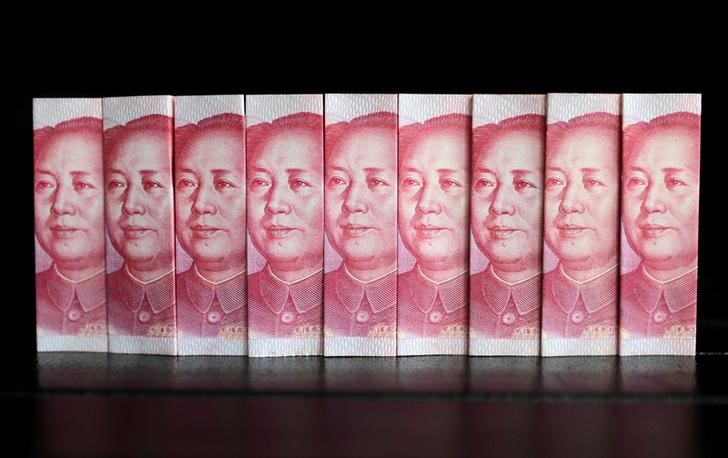By Saikat Chatterjee and Michelle Chen
HONG KONG (Reuters) - The Chinese central bank's clampdown on bearish yuan speculators that stunted offshore trading has inadvertently injected new life into the sleepy non-deliverable forwards (NDF) market.
Over-the-counter NDFs, which became sidelined after China started promoting the deliverable offshore yuan market six years ago, are a less risky channel now for hedge funds to bet on yuan/dollar volatility, traders said.
And more erratic daily midpoint fixings - since the People's Bank of China (PBOC) indicated it would manage the exchange rate within a trade-weighted basket of currencies - have also helped to rekindle activity in the shadowy but deep markets of NDFs traded globally, benefitting banks and companies who do business in China and need alternative ways to hedge currency exposure.
Wider use of NDFs, however, will be a setback for those hoping offshore yuan will hasten the internationalisation of the renminbi.
"The dollar/yuan NDF market is becoming more attractive to speculators such as hedge funds these days as there's no central bank intervention there and it's easier for them to bet on the yuan's movement," said Wang Ju, a senior strategist at HSBC in Hong Kong.
"They don't have to worry about the different ways the PBOC used to intervene in the CNH (offshore yuan) market and possible liquidity shortages. As long as they can find counterparties, they can trade in the NDF market."
Wang said real money investors may also find NDFs appealing when interventions increase in the offshore yuan, although that remains the main venue for hedging currency risk.
The central bank's attempts to deter speculation on the Chinese currency in the last few months have depressed a range of yuan assets offshore, including yuan-denominated "dim sum" bonds.
Traders estimate that offshore yuan volumes have dropped to around $3 billion to $5 billion a day, half of the peak they used to reach.
In contrast, daily trading volume of dollar/yuan NDFs has roughly doubled, rising to between $1.5 billion to $2 billion.
Faced with mounting capital outflows, the PBOC acted through state-owned banks in January to buy up CNH to check the yuan's slide and narrow the gap between offshore and onshore prices. To make it harder to short the yuan, it also ordered banks to set aside a portion of offshore yuan deposits as reserves.
The head of strategy at an Asian hedge fund, who declined to be named because of compliance reasons, said CNH has ceased to reflect onshore market fundamentals.
NDFs are now pricing in 3 percent weakness for the yuan in a year's time in contrast to onshore forwards pricing in only 1 percent weakness over the same period.
CNH FALLOUT
The PBOC's interventions might have managed to stamp out market volatility but its actions have led to a loss of confidence in the CNH market.
Hong Kong is the biggest market for offshore yuan and shrinking demand has hurt banks' fees and commissions and even affected jobs, as some institutions had set up dedicated CNH trading desks.
Exporters and importers may also trickle back to NDFs to avoid excessive volatility in CNH, analysts say. Many companies were caught off guard this year by the PBOC's yuan buying operations in Hong Kong, which erased the yuan's discount to the onshore rate and jacked up yuan borrowing costs.
In January, the three-month borrowing rate in the offshore currency soared to more than 10 percent before falling back to under 3 percent.
"Investors lost money in the offshore deliverable market as the central bank intervened several times, which pushed some to the NDF market where they only need to bear the fixing risk," said a trader at a Chinese Bank in Hong Kong.

Unless there is a big increase in the offshore CNH liquidity pool, interest in CNH may stay lukewarm for a while.